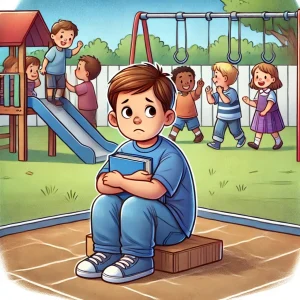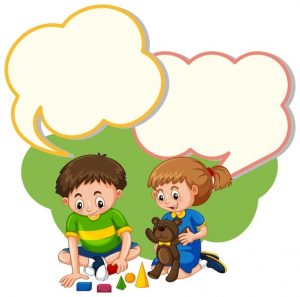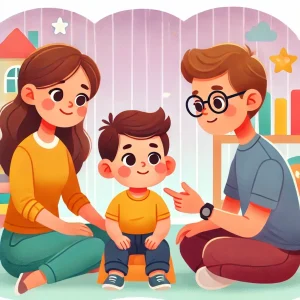Top 9 Speech Therapy Techniques for Down Syndrome
By Rajini D
Last Updated: February 29, 2024
Imagine sitting with your child, eager to understand their thoughts but struggling to connect through words. For many parents of children with Down syndrome, this is a familiar experience. However, speech therapy offers hope—it’s not just about speaking but about unlocking self-expression, building confidence, and enhancing social interactions. Every child is unique, and these therapies are tailored to their individual needs.
In this guide, we’ll cover the Top 9 Speech Therapy Techniques for Down Syndrome, designed to help your child communicate more effectively and find their voice in the world. Let’s explore these transformative strategies together.
Understanding Down Syndrome and Speech Therapy
Down syndrome, also called Trisomy 21, is a genetic condition where children have an extra copy of chromosome 21. This extra chromosome can affect how they develop, especially when it comes to speech and language. Many children with Down syndrome may find it harder to speak clearly, understand language, or express themselves, but each child’s abilities and learning pace are unique.
Speech therapy plays a crucial role in helping children with Down syndrome improve their communication skills. It’s not just about learning words—it’s about giving them tools to express their thoughts and feelings. Speech therapy helps them speak more clearly, understand language better, and communicate more effectively in their daily lives.
For example, a child named Sarah might struggle to say certain words. Through speech therapy, she can learn to break words into smaller parts and practice sounds, which helps her communicate better over time. This boosts her confidence and allows her to engage more with friends and family.
Also read: Why Speech Therapy is Crucial for Down Syndrome Children
Technique 1: Simple Gestures and Sign Language
Before a child learns to speak, gestures can serve as an important way to communicate. For children with Down syndrome, using simple gestures and sign language can be an effective bridge to communication. These techniques allow children to express their needs and emotions even before they can say the words, helping to reduce frustration and encourage interaction.
At Wellness Hub, we’ve seen how incorporating sign language into speech therapy can make a big difference. It’s not just about teaching signs but about giving children the confidence to express themselves. For instance, a child might use the sign for “more” when they want a snack, or “help” when they’re struggling with a task. These small victories in communication can motivate children to keep trying, building the foundation for future speech development.
By teaching basic signs and gestures, parents and caregivers create a way for children to communicate their everyday needs, like asking for food or indicating they need help. This reduces misunderstandings and helps the child feel understood, which is a big step toward creating a positive learning environment.
Read more about on What is the Relation between Communication, Speech and Language? | Speech and Language Therapy
Technique 2: Interactive Singing and Music
Music is a joyful and highly effective tool for speech therapy. For children with Down syndrome, interactive singing and music help improve speech clarity and rhythm while making learning fun. When children sing, they practice controlling their breathing and vocal cords, both of which are essential for clear speech.
Singing also introduces rhythm, which is helpful for speech development. For example, singing songs with a steady beat helps children learn the natural rhythm of speech, which can be a challenge for some. Songs with repetitive lyrics, such as “Twinkle, Twinkle, Little Star,” help children practice sounds and words over and over, making it easier for them to grasp pronunciation and language patterns.
A great way to incorporate this at home is by turning daily routines into musical activities. For instance, during bath time, you can sing simple songs, turning an ordinary moment into a fun learning experience. Not only does this strengthen speech skills, but it also makes everyday tasks enjoyable and interactive, contributing to the child’s overall development.
Read more about on Art and Music in Online Therapy: A Path to Emotional Expression
Technique 3: Turn-Taking Games
Conversations are like taking turns, where we speak and listen. Turn-taking games help children with Down syndrome learn this important skill. These games show them how to wait, listen, and then respond, which improves their communication and social skills.
Simple games like rolling a ball back and forth, where the child says a word each time they pass the ball, can be fun and educational. Board games that require waiting for a turn are also great. These activities teach patience and help children engage better in conversations with others.
Technique 4: Facial Expression Recognition
Communication isn’t just about talking; it’s also about understanding facial expressions. For children with Down syndrome, learning to recognize and mimic facial expressions is an important step in understanding emotions.
You can start with picture cards showing different facial expressions or use a mirror to practice making faces. For example, show a happy or sad face and ask your child to copy it. Over time, they will better understand how facial expressions connect to emotions.
This practice helps children become more aware of others’ feelings, making them better at understanding social cues and connecting with people emotionally.
Technique vs. Skill Enhanced
| Technique | Skills Enhanced | Example Activities |
|---|---|---|
| Sign Language | Basic Communication, Vocabulary | Signing for ‘more’, ‘finished’, ‘eat’ |
| Interactive Singing & Music | Speech Articulation, Rhythm | Singing “The Wheels on the Bus”, Using hand drums |
| Turn-Taking Games | Social Skills, Communication | Playing “Simon Says”, “Red Light, Green Light” |
| Facial Expression Recognition | Emotional Understanding, Communication | Mimicking and guessing emotions using flashcards |
| Oral-Motor Exercises | Speech Muscle Strength | Blowing bubbles, Using straws |
| Modeling Clear Speech | Speech Clarity, Listening Skills | Repeating phrases clearly, Reading aloud slowly |
| Following Instructions | Comprehension, Execution of Commands | “Put the toy in the box”, “Hand me the ball” |
| Reading & Storytelling | Vocabulary, Comprehension, Imagination | Reading picture books together, Telling stories from pictures |
| Vocabulary Building | Vocabulary Expansion, Sentence Formation | Naming objects during a walk, Describing actions during play |
Technique 5: Building Vocabulary with Everyday Activities
Building vocabulary is a key part of communication, and for children with Down syndrome, everyday activities provide perfect learning opportunities. By naturally introducing new words during daily routines, learning becomes both fun and effective.
For example, while walking in the park, you can point to objects like trees, birds, or swings, and say their names. At mealtime, talk about the food on the table—describe its color, taste, or texture. This makes learning words more meaningful and easier to remember.
Every new word your child learns is a step toward better communication, so celebrate each small success! These moments of discovery encourage curiosity and foster a love for learning.
Learn more about Toddler Speech Development: From Babbling to First Words
Technique 6: Following Simple Instructions
Understanding and following simple instructions is an essential communication skill, especially for children with Down syndrome. It helps them not only with speech development but also in day-to-day activities, leading to greater independence.
Start with one-step instructions, like “Please hand me the ball,” paired with a visual cue, such as extending your hand. This makes it easier for your child to understand the request. As they get more comfortable, you can introduce two-step instructions, such as “Pick up the toy and put it on the table.”
Consistency and repetition are key. By regularly practicing these tasks, your child will build confidence and master the skill, making it part of their daily routine. Celebrate each success to keep them motivated!
Technique 7: Oral-Motor Exercises
Oral-motor exercises help strengthen the muscles used for speaking, which is especially important for children with Down syndrome. These exercises focus on improving lip, tongue, and jaw movement to support clearer speech. One fun and effective activity is blowing bubbles.
Blowing bubbles might seem like simple play, but it helps with lip rounding, breath control, and coordination—skills needed for speech. Encourage your child to blow bubbles through different-sized wands or try blowing bigger bubbles. This enjoyable activity can be done anywhere and serves as a playful way to build muscle strength for speech.
Technique 8: Modeling Clear Speech
Children often learn by copying what they hear, making it important for parents and caregivers to model clear and slow speech. When you speak slowly and clearly, you give your child a strong example to follow, which helps them learn how to articulate words.
In households where more than one language is spoken, it’s helpful to use the language that feels most comfortable during learning sessions. Consistency in how you speak is key. It’s not about being perfect—it’s about giving your child a clear model to imitate and encouraging steady progress.
Technique 9: Reading and Storytelling
Reading and storytelling are powerful tools for building vocabulary and language understanding in children with Down syndrome. Through stories, children can learn new words, grasp the flow of conversations, and connect emotions to characters and situations.
Choose books with simple text and bright, engaging pictures. As you read, encourage your child to point to objects and name them. You can also ask questions like, “What is the dog doing?” to make reading interactive. This turns reading into a fun, two-way activity that keeps them involved and thinking.
Storytelling, whether you’re reading from a book or telling a tale from memory, stimulates your child’s imagination and strengthens their language skills. It’s an enjoyable way to bond while boosting their ability to communicate.
Weekly Speech Therapy Activity Planner
| Day of the Week | Technique Focus | Activity Suggestion |
|---|---|---|
| Monday | Sign Language | Practice signing “more”, “all done”, and “eat” during meal times. |
| Tuesday | Interactive Singing & Music | Have a sing-along session using children’s songs about daily routines. |
| Wednesday | Turn-Taking Games | Play a simple board game emphasizing taking turns and using polite requests. |
| Thursday | Facial Expression Recognition | Use a mirror to make different faces together, discussing what each expression means. |
| Friday | Oral-Motor Exercises | Spend time blowing bubbles or balloons to strengthen mouth muscles. |
| Saturday | Modeling Clear Speech | Pick a book and read aloud, focusing on clarity and pacing of speech. |
| Sunday | Following Instructions | Create a fun scavenger hunt with simple two-step instructions to find items around the house. |
Conclusion
Speech therapy can be life-changing for children with Down syndrome, helping them express themselves and connect with others. Using techniques like sign language, interactive singing, and turn-taking games makes learning fun and engaging. Oral-motor exercises strengthen speech muscles, while activities like storytelling and following instructions build vocabulary and communication skills. Every child’s progress is unique, so celebrate small wins along the way. Wellness Hub offers valuable resources and support to help parents apply these techniques at home. Explore more on speech and language milestones and speech therapy at home tips with Wellness Hub to enhance your journey!
Frequently Asked Questions:
1. What are effective speech therapy techniques for children with Down syndrome?
Effective speech therapy techniques for children with Down syndrome include simple gestures and sign language, interactive singing and music, turn-taking games, facial expression recognition, oral-motor exercises, modeling clear speech, following simple instructions, and engaging in reading and storytelling activities.
2. How can sign language benefit a child with Down syndrome?
Sign language provides a visual and kinesthetic mode of communication for children with Down syndrome, facilitating early communication skills before verbal abilities are fully developed. It helps reduce frustration by providing a means to express needs and emotions and supports the development of speech and language skills by reinforcing the connection between gestures and words.
3. Why is reading important for speech development in children with Down syndrome?
Reading to children with Down syndrome introduces them to new vocabulary, helps them understand sentence structure, and enhances comprehension skills. Interactive reading activities, such as asking questions about the story and encouraging children to point to pictures, stimulate language development and foster a love for storytelling.
4. Can oral-motor exercises improve speech clarity in children with Down syndrome?
Yes, oral-motor exercises strengthen the muscles involved in speech production, improving articulation and clarity of speech. Activities like blowing bubbles, using straws, and practicing sounds can help children with Down syndrome develop better control over their speech muscles, leading to clearer speech.
5. How does Wellness Hub support families of children with Down syndrome in speech therapy?
Wellness Hub offers a range of resources, expert advice, and personalized support to families of children with Down syndrome. With a focus on individualized therapy plans, Wellness Hub helps identify the most effective speech therapy techniques for each child, supporting their journey toward improved communication skills.
6. At what age should speech therapy begin for a child with Down syndrome?
Early intervention is key to maximizing the benefits of speech therapy for children with Down syndrome. Speech therapy can begin as early as infancy to introduce foundational communication skills and continue to evolve as the child grows to address developing speech and language needs.
7. How can parents and caregivers model clear speech for children with Down syndrome?
Parents and caregivers can model clear speech by speaking slowly, enunciating words clearly, and using simple language structures. It’s important to maintain eye contact and repeat keywords or phrases to reinforce learning. Incorporating gestures and visual aids can also enhance understanding and engagement.
8. What role do turn-taking games play in speech therapy for children with Down syndrome?
Turn-taking games teach children the structure of conversation, including listening, waiting for their turn, and responding. These games improve social communication skills, encouraging children with Down syndrome to engage in interactions more confidently and effectively.
9. How do songs help children with Down syndrome speak better?
Songs help children with Down syndrome by making it fun to learn new words and sounds. Singing together can improve how they say words and understand the rhythm of speech. It’s like playing with music while learning to talk.
10. What simple games can teach children with Down syndrome to follow instructions?
Playing simple games like “Simon Says” or “Red Light, Green Light” helps children with Down syndrome listen and follow instructions. These games are fun ways to practice listening and doing what they are told, using easy steps.
About the Author:
Rajini, Speech-Language Pathologist:
Rajini is a dedicated Speech-Language Pathologist with a focus on developmental speech and language disorders in children and rehabilitation in adults. With a passion for helping each individual find their voice, Rajini brings a wealth of experience and a heartfelt approach to therapy. At Wellness Hub, she’s part of a team that values innovation, compassion, and results-driven practices.
Book your Free Consultation Today
Parent/Caregiver Info:
Client’s Details:
* Error Message









